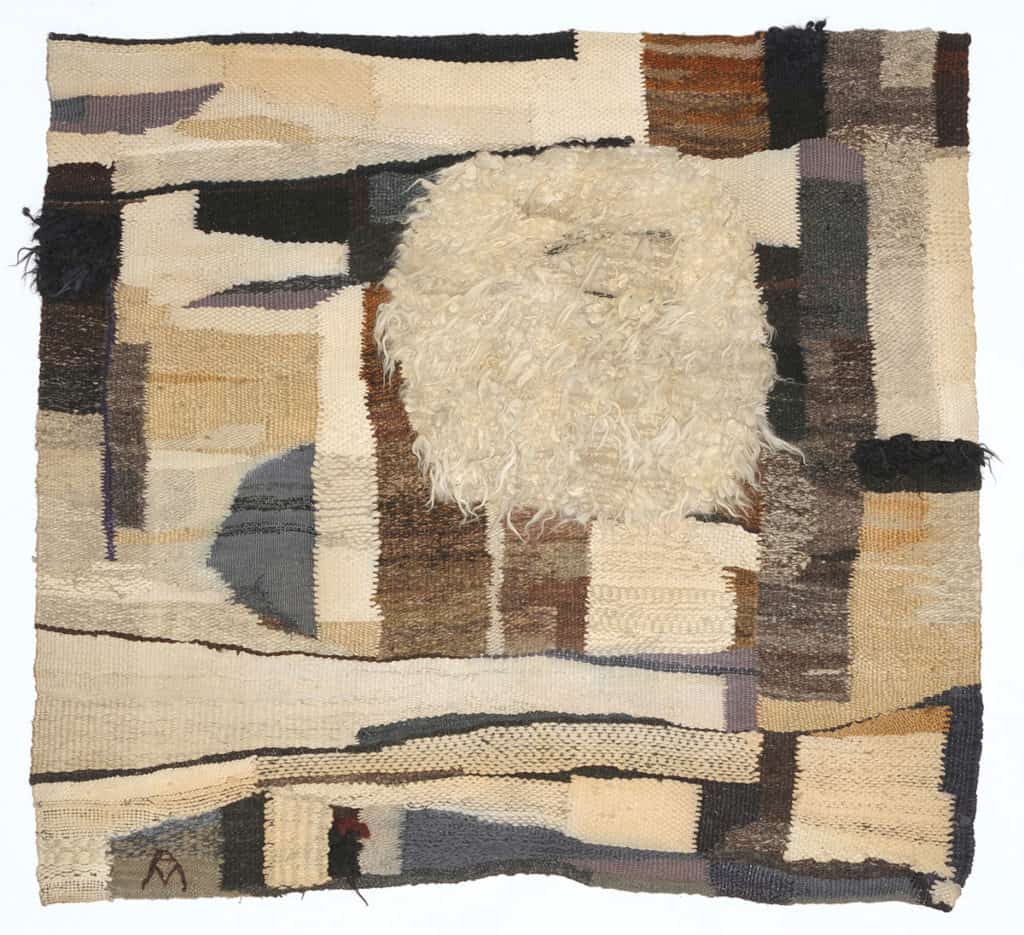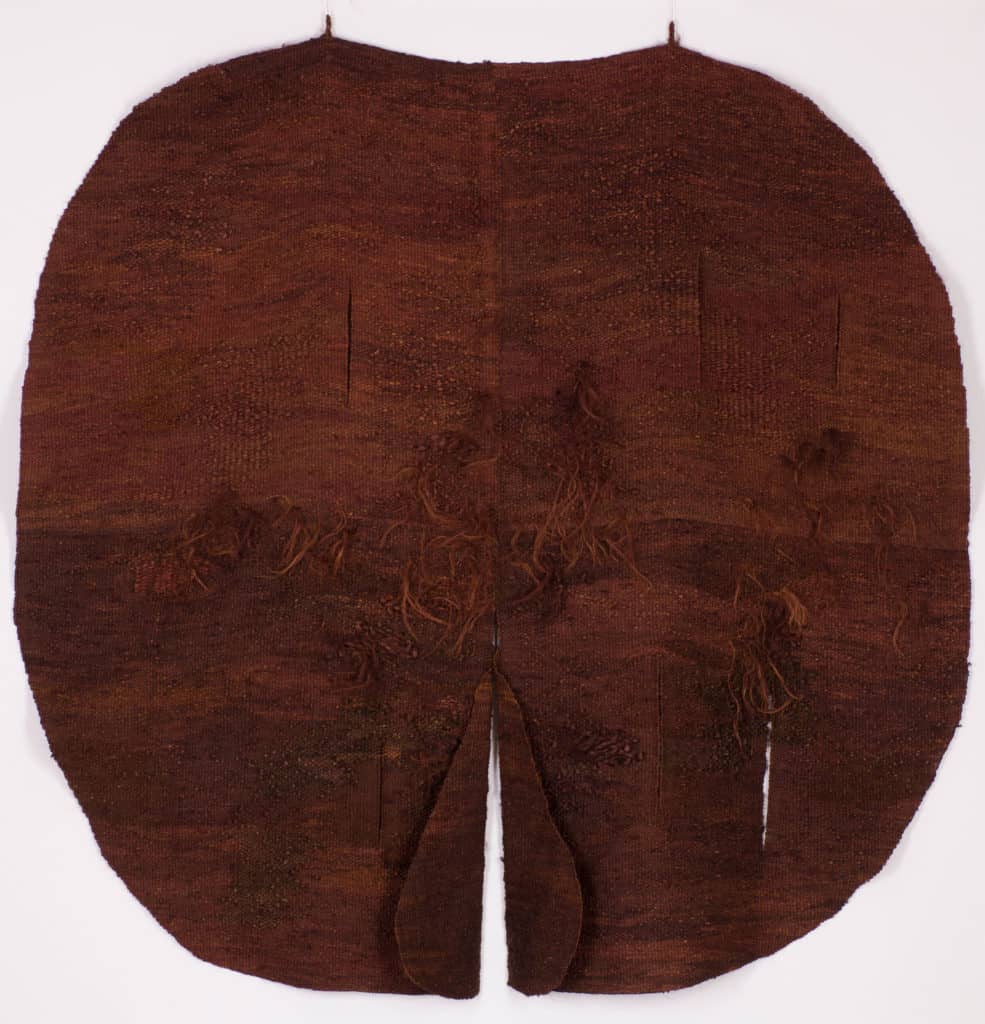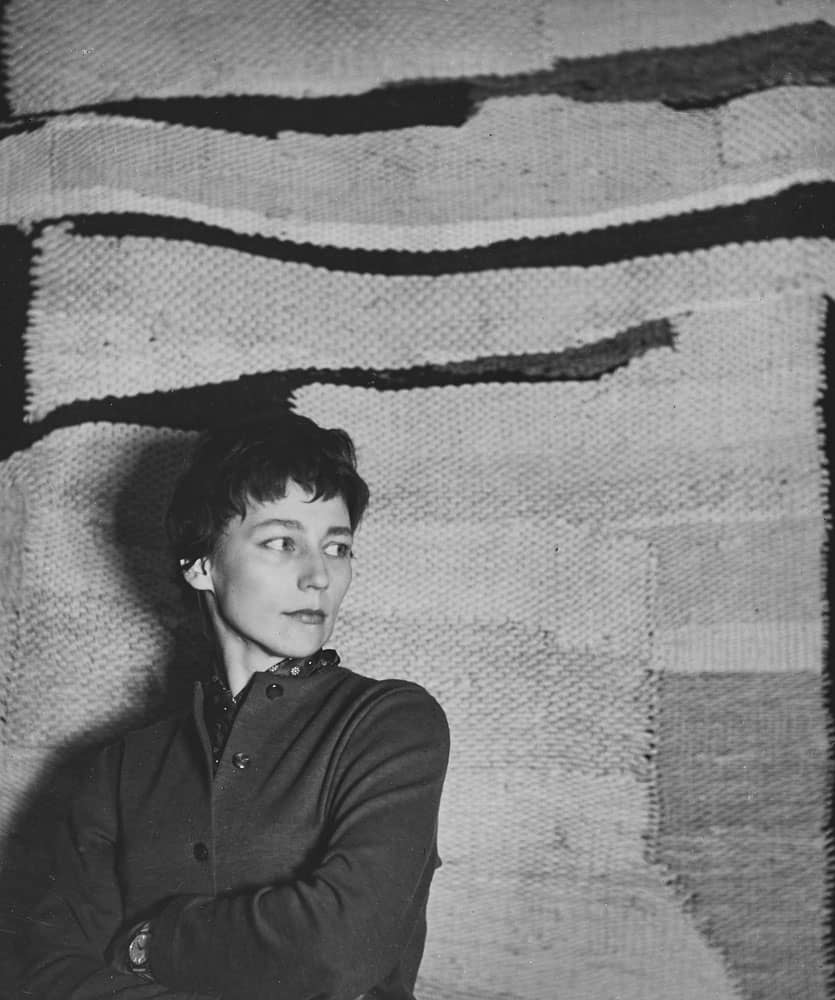Magdalena Abakanowicz, 1960s, photo artist’s archive
Sylwia Krasoń: The exhibition ‘Metamorphism’ at the Central Museum of Textiles in Łódź is a presentation of Magdalena Abakanowicz’s work with a focus on the artist’s fascination with textiles. How did she start working with this form of artistic expression?
Marta Kowalewska: The textile accompanies Magdalena Abakanowicz from the very beginning of her artistic path. In 1949 she began her studies at the Higher School of Fine Arts in Sopot, but soon she moved to Warsaw to join the Department of Textiles (part of the Painting Faculty) at the Academy of Fine Arts. She wanted to specialise in this particular field. She studied with two of the most important professors, who were known for laying a solid foundation of the so-called ‘Polish Textile School’ and its success: Anna Śledziewska and Eleonora Plutyńska.
The third among the group of the most exceptional textile teachers at the Academy of Fine Arts in Warsaw was Mieczysław Szymański. However, he did not teach Magdalena Abakanowicz or at least, there is no evidence in the archives, even though the artist repeatedly referred to his authority. In her later works, we can see that she was influenced by Szymański’s ideas on differentiating fabric textures within one piece of work and incorporating the materials not previously associated with fabric, such as horse hair or metal elements. The thinking of fabric as a form of construction or the idea of building structures on the warp during the weaving process to reveal its ‘skeleton’ were ideas professor Szymański has instilled in his students.
During her studies, along with fellow students, Abakanowicz did various jobs related to the design of jacquard textiles intended for government buildings. Some of her designs were also used as a book cover for the “Polish textiles” publication edited by Ksawery Piwocki. Her diploma in 1954 was also related to this field. Shortly after graduation, she started working at the Central Silk Plant in Milanówek. She was the artistic director of the weaving factory. So, textiles in a broad sense were in the centre of Abakanowicz’s interest from the very beginning. As a visual artist she began experiments with painted fabrics, but soon she became interested in the possibilities offered by the weaving process regarding the creation of spatial structures.

Magdalena Abakanowicz, White (The Sun and the Moon), 1964
SK: The use of textiles in the 1960s was associated mainly with crafts and interior design. Abakanowicz broke the cliché and used fabric to express emotions in her artistic output. What were the critical stages in Abakanowicz’s oeuvre?
M.K.: Indeed, the textiles of the early 1960s were perceived as crafts due to its utilitarian function. Textiles were linked to architecture and seen as an element of interior décor. It was the artists from the post-war generation affiliated to the Academy of Fine Arts in Warsaw, who changed the perception on textiles. They created the ‘Polish Textiles School’, and Magdalena Abakanowicz quickly became its leading figure.
On the one hand, trying war experiences, and on the other hand, the ‘thaw’ period in the second half of the 1950s, spurred a whole generation of young artists who felt a burning need to stand in opposition to the existing rules and to create courageous art regarding the form and the meaning. They were not afraid to break formal limits, and Abakanowicz with her audacity in artistic exploration was a leader in creating new solutions at the crossroads of various disciplines. In the ‘Metamorphism’ exhibition I wanted to show this important time of the birth of ideas, the artistic ferment and her courageous thinking. I believe that the period of Abakanowicz’s work in textiles and the transformation of structures is when she was at her most avant-garde. I think that the most innovative part of her oeuvre is when she crossed the boundaries of the traditional perception of textiles by experimenting with the texture and the structure of fabrics, to finally win for it a full autonomy as a form of art. I also wanted to draw the audiences’ attention to the process of creating the first structural textiles with a fleshy, multidimensional surfaces, woven by threads of various thickness and textures.
The ‘Abakans’ raised the unique type of textiles to the level of fully-fledged artistic freedom. The subsequent editions of Biennial of Lausanne, organised since 1962, are perhaps good milestones. Every two years Abakanowicz presented something unique, which touched the art world and encouraged other artists to try new formal solutions. It is important to mention, however, that all her work derived from her inner need to create her personal world. She did not stop experimenting. Continuing with her focus on soft materials, she built figurative and non-figurative sculptures made out of bag-like fabrics and resin – “Alterations” (Alteracje). In the later years, her focus shifted to bronze, stone, wood and iron. She employed her vision in architecture (such the project of the expansion of the Parisian Axis, the concept of a modern city). Her art also entered the field of music and dance in the form of her choreography inspired by her sculptures. All these activities ventured beyond the gallery space and the limits of art.

Magdalena Abakanowicz, 1960s, photo artist’s archive
SK: ‘Abakans’ are huge and thick, and look like soft and loose dangling carpets in organic shapes. Abakanowicz hung them in the air, giving them the third dimension. Before she developed this form, she also created the so-called ‘structural textiles’. What was that?
M.K.: Magdalena Abakanowicz is one of the most famous Polish artists, and ‘Abakans’ are her hallmark. However, these spatial forms were preceded by many years of research and experiments with form and materials. The exhibition ‘Metamorphism’ presents her artistic evolution. Starting with the painted fabrics (we show her painted fabric from the 1960s), through a series of flat tapestries, to the structural textiles. Her first woven works had an elaborate structure of textures, abstract compositions, where forms were highlighted by shades of colours and a variety of woven surfaces. The piece entitled “Composition of White Forms” (“Kompozycja Białych Form”) from 1962 presented at the First Lausanne Biennial is a good example. The composition delights with a variety of textural solutions; one senses the plasticity of abstract forms. With time, the surface of fabrics became increasingly more diverse even though the composition still yielded to the flatness of a wall. Nevertheless, these works already had developed layers of weaves and varied thickness of materials. Her way of using the woven materials already gave an insight into her spatial thinking about the form. The surfaces of these tapestries are full of cracks, fissures, holes that encourage us to look deeper inside their structures.
SK: Weaving and knitting are tedious and physically exhausting activities that require a lot of patience. Looking from a pragmatic point of view, what did her daily work with the textiles look like?
M.K.: According to the archives, Abakanowicz had an exceptionally regular daily working schedule. Since 1968, her studio was located on the 10th floor of an apartment block. She started work at 8 AM. Her assistants came in at eight too, to weave together. The assistants finished work at 4 PM, but Abakanowicz continued to weave into the evening with a break to write letters (as she kept in touch with lots of people). Naturally, the large size of her works presented difficulties, particularly given that her studio was in a flat. She developed a suspension system that allowed her to raise and join fabrics together. After all, it was impossible to create such intricate yet massive forms as one whole from the start. They were made piece by piece and later sewn together. It was also complicated to carry the finished works out of the studio. Some of the works were pulled out of through the window and lowered down on ropes from the tenth floor. The complicated and tedious process of dyeing fabrics was also taking place in her atelier.

Magdalena Abakanowicz, Brown Abakan IV, 1969
SK: Abakanowicz used to say in interviews that her ‘Abakans’ irritated. However, they also intrigued and were appreciated at major international competitions, because, in her own words, “they were magical, complicated, huge”. Today we see, that her woven work has given the revolutionary tone to changes in the artistic expression in the field of visual arts. What was the revolution about?
M.K.: The fabric was elevated to an independent art form with its own right to explore the form and its own semantics. Polish artists, led by Magdalena Abakanowicz, began to treat fabrics as a full-fledged matter of artistic expression, created by hand in a weaving workshop. At the time, in the west, an artist would make a design, and a team of highly skilled craftsmen would then accurately reproduce it on fabric, somehow losing the identity of the material in the process. In contrast, Abakanowicz was fascinated by the tactile nature of woven structures, their texture, soft plasticity, and even the smell. No other material, no other field of art was giving the artist such a rich array of artistic expressions. The freedom to shape the structure and define its meaning, elevated textiles beyond their decorative functions, and to a vessel for new interpretations. In 1969, the famous “Wall Hangings” exhibition opened at the MoMA in New York. It was Abakanowicz who presented the boldest solutions, annexing space, creating her world of organic forms. She continued shifting boundaries by creating works that were disturbing in their biology, captivating, incredibly sexual, sensual, and audacious.
SK: Abakanowicz was an ‘outsider’. Her art was not easy to classify and did not fit into any contemporary art movements. As she admitted in one of the interviews, no one promoted her, yet thanks to her tenacity and talent she gained international success. In your opinion, what could young artists learn from Abakanowicz?
M.K.: When Abakanowicz began to work with textiles in the mid-1950s, the field was neither seen as pure art from nor was it popular. No one could have predicted the outburst of popularity in textiles only a few years later. Yet, Abakanowicz chose fabric. You can see a lot of determination, but also the courage to explore an unknown area of art. Her will to search for the ‘new’ can also be seen in her later activities. After all, her famous ‘Abakans’ did not appear unannounced – they were preceded by the artist’s recognised and award-winning textile works. Her courage also shined through in her later decisions. It is important to note, that even when she found her style and language of expression, she did not stop searching, her journey never stopped. The lesson from Abakanowicz is to reject the conventional way of thinking and search for a new perspective. It is also about faith in one’s ideas and trust in one’s decisions. Her persistence gave her the possibility to use her experience to continue discovering new areas of art.
‘Metamorphism. Work by Magdalena Abakanowicz’ is on show at the Central Museum of Textiles in Łódź,
30 Nov 2017 – 1 April 2018

Magdalena Abakanowicz, The Composition, 1960

Magdalena Abakanowicz, 1960s, photo artist’s archive

Magdalena Abakanowicz, White, 1966








